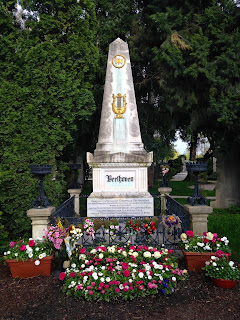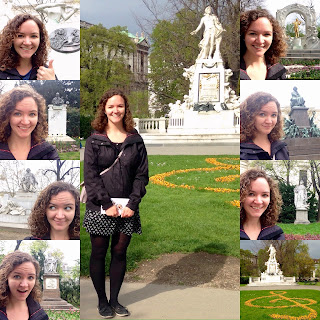Fortunately, I don't think it's possible to separate Vienna from its classical music history, and I left with some beautiful memories and would definitely go back to hear more music.
 |
| Mozarthaus |
| St. Charles Church |
One absolute must-see in Vienna is Schönbrunn Palace, just outside the center of town. Because of its size and large adjacent gardens, it's a bit like a mini-Versailles. Schönbrunn's added bonus is a ban on all photography inside the palace; people tend to walk through the rooms at a normal pace and you don't repeatedly walk into the guy in front of you who feels the need to take a picture of every chair.
Schönbrunn was built around 1640, but it is best known for its style since its remodeling around 1740-50, when Empress Maria Theresa lived there. The palace has a rather varied interior mostly representing two distinct periods of history: the Rococo-style rooms of Empress Maria Theresa's time and the neoclassical rooms of Franz Joseph I (1830-1916), the longest-reigning emperor of Austria. The Rococo rooms are, of course, over the top, with gold, intricate carvings, elaborate wallpaper, and paintings. The neoclassical style, in contrast, is much simpler; though he was one of the most important ruler's in Austria's history, Franz I's bedroom and bed were tiny and unimpressive. I liked both styles, but my favorite was of course the Mirror Room, decorated in white, gold, and deep pink. This was where Mozart gave his first concert to Empress Maria Theresa at the age of six.
| Gloriette |
Upon returning to the center of town, it was obvious that the weather was not going to cooperate for a nice afternoon outside, so I ended up at Hofburg Palace, the former imperial palace. It's been through many renovations going back to the 1400s, but today houses a museum with three parts: the Imperial Apartments, the Sisi Museum, and the Silver Collection. I passed first through the Silver Collection, which readily blew my mind; it houses endless collections of royal silverware and takes you through the changes in table setting style over the decades. The Imperial Apartments were nothing special after Schönbrunn, but the real draw is the Sisi Museum, following the life of Empress Elisabeth, the wife of Franz Joseph I. She was born in Munich, which was then part of the Kingdom of Bavaria, and married rather young into Austrian royalty. Despite her privilege, she had difficulties all her life adjusting to being in the royal spotlight, and was eventually assassinated in Geneva. The museum effectively displayed the complications of her life in an objective way.
When you are all museumed out on a rainy day in Vienna, there is a solution: Demel, a fancy tea and cake shop. If you want to sit down and eat or drink, there is a lengthy and rather confusing process; I finally snagged a table after an hour of waiting. I was happy with my hot chocolate and whatever cake I chose (due to the treble clef written on it in icing).
My anticipated moment of the weekend happened late Sunday morning. Before the vacation, I had found advance tickets for the Vienna Philharmonic matinée for six Euros! What a deal. I was expecting general admission nosebleed seats, but acoustics in the back of the hall are usually better anyway. I arrived at the music hall and collected my ticket, which read Stehplatz, and then shuffled into a long line. The doors opened and we were let loose into the hall, which brings me to my:
Stehplatz - standing room
We were put into a small area on the ground floor in the back of the hall where there was much shuffling and craning of necks in order to see anything. Once the concert started, many people dropped like flies and sat on the floor. I wasn't sure how my legs would hold up being crunched in a small space for two hours, but if I was uncomfortable, I didn't notice at all: that is how incredible the Vienna Philharmonic was. I even splurged on a program this time, and during the second half, I could see most of the right side of the stage, including the flute players. The guest conductor was none other than the "Dude" - Gustavo Dudamel, the Venezuelan conductor of the Los Angeles Philharmonic. The highlight of the concert was Modest Mussorgsky's Pictures at an Exhibition, already a powerful piece. Thanks to the acoustics of the hall, the cohesiveness of the orchestra, and the clearest of tones from every musician, you could hear every instrument perfectly, and they were all completely in sync. The ending left everyone speechless...and I realized afterward that I hadn't given my legs a single thought during the whole piece.
I could move to Vienna just for the six-Euro standing room tickets.
You know you've been traveling alone too long when you start playing the statue selfie game. After the concert, there was a marathon blocking much of Vienna, and the sun started peeking out, so I naturally decided to hunt down every musical composer statue in the city. I believe I hit them all: Brahms, Beethoven, Gluck, Bruckner, Schubert, Mozart, Strauss, and Vivaldi.
 |
| Beethoven |
 |
| Brahms |
 |
| Mozart |
That is where my solo travels ended; next stop is Kraków, Poland.




No comments:
Post a Comment